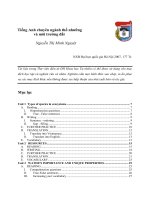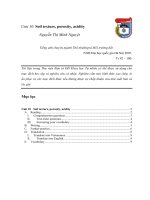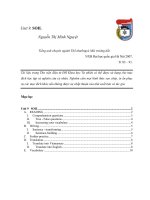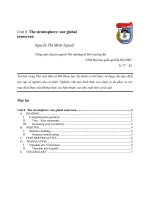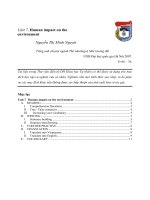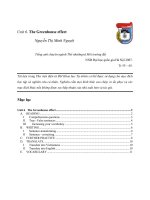Tiếng anh chuyên ngành Thổ nhưỡng và Môi trường đất phần 8 potx
Bạn đang xem bản rút gọn của tài liệu. Xem và tải ngay bản đầy đủ của tài liệu tại đây (184.49 KB, 8 trang )
Tiếng anh chuyên ngành Thổ nhưỡngvà Môi trường đất
NXB Đại học quốc gia Hà Nội 2007.
Tr 77 – 82.
Tài liệu trong Thư viện điện tử ĐH Khoa học Tự nhiên có thể được sử dụng cho mục đích
học tập và nghiên cứu cá nhân. Nghiêm cấm mọi hình thức sao chép, in ấn phục vụ các
mục đích khác nếu không được sự chấp thuận của nhà xuất bản và tác giả.
Mục lục
Unit 8 The stratosphere: our global sunscreen 2
A. READING 2
I. Comprehension questions 2
II. True – false statements 3
III. Increasing your vocabulary 4
B. WRITING 4
I. Sentence-building 4
II. Sentence-transforming 5
C. FURTHER PREACTIVE 6
D. TRANSLATION 6
I. Translate into Vietnamese 6
II. Translate into English 7
E. VOCABULARY 7
Unit 8. The stratosphere: our global
sunscreen
Nguyễn Thị Minh Nguyệt
Unit 8
The stratosphere: our global sunscreen
A. READING
a. Warm-up Activities
- Where is the stratosphere?
- How important is the stratosphere?
The atmosphere’s second layer is the stratosphere, which extends from 17-18 kilometers above
Earth’s surface. It is a much more peaceful place than the troposphere. Although the stratosphere
contains less matter than the troposphere, its composition is similar, with two notable exceptions.
Its volume of water vapor is about 1,000 times less and its volume of ozone (O
3
) is about 1,000
times greater.
Stratosphere ozone is produced when some of the stratosphere’s oxygen molecules interact with
lighting and solar radiation. This thin layer of ozone keeps about 99% of the harmful ultraviolet
radiation given off by the sun from reaching Earth’s surface. This filtering action protects us from
increased sunburn, skin and eye cancer, cataracts and damage to the immune system. This global
sunscreen also prevents damage to some plants, aquatic organisms, and other land animals.
Furthermore, it keeps much of the oxygen in the troposphere from being converted to toxic ozone
by incoming UV radiation. The trace amounts of ozone that do form in the troposphere as a
component of urban smog damage plants, the respiratory system of humans and other animals,
and materials such as rubber.
Thus our good health and that of many other species depend on having enough "good" ozone in
the stratosphere and as litter as possible "bad" ozone in the troposphere. Unfortunately, our
activities are increasing the amount of harmful ozone in the tropospheric air we must breathe and
decreasing the amount of beneficial ozone in the stratosphere.
Air in the stratosphere, unlike that in the troposphere, is calm, with little vertical mixing. Pilots
like to fly in this layer because it has so little turbulence and such excellent visibility. Flying in
the stratosphere also improves fuel efficiency because the thin air offers little resistance to the
forward thrust of the plane. And unlike the troposphere, temperature rises with altitude in the
stratosphere until there is another reversal at the stratopause, which makes the end of the
stratosphere and the beginning of the atmosphere’s next layer.
(Taken from "Sustaining the Earth" by Tyler Miller, G)
I. Comprehension questions
Answer the following questions
1. Where is the stratosphere ?
2. How useful is the stratosphere ozone to life on Earth?
3. What do our good health as well as that of many other species rely on?
4. What are advantages of flying in the stratosphere ?
5. What leads to the increase in the amount of harmful ozone in the tropospheric air we must
breathe and decrease the amount of beneficial ozone in the stratosphere?
II. True – false statements
Decide whether the following statements are true (T), false (F) or there’s no information
given (N) according to the text.
Air in the troposphere is as calm as that in the stratosphere.
The composition of the stratosphere is similar to that of troposphere except for
its volume of water vapor and its volume of ozone.
Human activities are decreasing the amount of harmful ozone in the
tropospheric air we must breathe and increasing the amount of beneficial ozone
in the stratosphere.
The troposphere extends only about 17 kilometers above sea level at the equator
and about 8 kilometers above the poles.
In the stratosphere, temperature rises with altitude.
III. Increasing your vocabulary
Find word or phrase in the text that have the same meaning to:
1. very small quantities
2. the system protecting against infection
3. poisonous
4. plants and animals living in water
5. power of resisting
B. WRITING
I. Sentence-building
Make any changes and additions to complete the following sentences.
6. Small amounts / carbon dioxide / water vapor / trace amounts / ozone, methane, nitrous
oxide, chlorofluorocarbons / other gases / troposphere / play / key role / determine / Earth’s
average temperature.
7. Because / population growth, / one out of three persons / world / lack / enough fuel / keep
warm / cook food.
8. A potentially renewable resource / can / renew / fairly / quick / through natural processes.
9. Unless / fertilizers / be / use / properly, / agriculture productivity / be / increase.
10. Environment science / be / study / how / we / other species / interact / one another / the non-
living environment of matter and energy.
II. Sentence-transforming
Rewrite the following sentences without changing their meanings.
1. Unless it rains, millions of pounds’ worth crops will be lost.
If
2. It was dark and consequently photosynthesis couldn’t take place.
It was too
3. We should use cleaner and safer fuels to control and reduce air pollution.
In order
4. Daily temperature fluctuations seldom affect the soil deeper than about 30-40m.
Daily temperature fluctuations seldom have
5. As we are burning more and more fossil fuels (coal, oil, natural gas), they will soon become
extinct.
The more
C. FURTHER PREACTIVE
Gap-filling: Choose one suitable word among the given words. Each is used once only.
than vary a level and
effect more the layers with
affect fluctuate Earth surface climate
fewer changes fluctuations atmosphere temperature
Soil temperatures resulting from the sun’s radiation change with the depth (1)
with the time of day. For example, the maximum daily (2) at deep soil depths is
delayed, even by several hours, after the time when the air temperature reaches a maximum.
Conversely, on cool nights, the deep soil (3) don’t cool as fast as 4)
layers because of the insulting effect of the overlying soil . Heat flow is slower in soil than in the
(5) . The deeper the soil layer, (6) longer it takes a temperature change to
reach it and thus the less will be the actual temperature fluctuation from day to day or week to
week. Daily temperature (7) seldom (8) the soil deeper than about 30-40
cm. Below about 1m the soil (9) slowly from season to season. The mean summer and
mean winter temperatures at 1m deep seldom differ by (10) than 5
0
C in the subtropics;
differences increase several degrees in temperate regions.
D. TRANSLATION
I. Translate into Vietnamese
Stratosphere ozone is produced when some of the stratosphere’s oxygen molecules interact
with lighting and solar radiation. This thin layer of ozone keeps about 99% of the harmful
ultraviolet radiation given off by the sun from reaching Earth’s surface. This filtering action
protects us from increased sunburn, skin and eye cancer, cataracts and damage to the immune
system. This global sunscreen also prevents damage to some plants, aquatic organisms, and other
land animals. Furthermore, it keeps much of the oxygen in the troposphere from being converted
to toxic ozone by incoming UV radiation. The trace amounts of ozone that do form in the
troposphere as a component of urban smog damage plants, the respiratory system of humans and
other animals, and materials such as rubber.
II. Translate into English
1. Việc sản xuất lương thực trên toàn cầu trong hai thập kỷ qua đã gia tăng một cách đáng kể.
Tuy nhiên đây cũng là một nguyên nhân dẫn đến sự ô nhiễm môi trường.
2. Hiệu ứng nhà kính gây ra do việc tăng lượng khí CO2 trong không khí có thể dẫn đến những
thay đổi quan trọng đối với khí hậu toàn cầu.
E. VOCABULARY
1. cataract (n) : bệnh đục thuỷ tinh thể
2. composition (n) : thành phần
3. extend (v) : mở rộng, kéo dài
4. immune system (n) : hệ thống miễn dịch
5. interact (v) : tương tác
6. molecule (n) : phân tử
7. notable (adj) : đáng chú ý, nổi bật
8. respiratory system (n) : hệ hô hấp
9. reversal (n) : sự đảo lộn
10. stratosphere (n) : tầng bình lưu
11. sunburn (n) : sự rám nắng
12. sunscreen (n) : tấm chắn bức xạ mặt trời
13.
thrust (v) : đẩy mạnh
14. troposphere (n) : tầng đối lưu
15. turbulance (n) : sự bất ổn, xáo trộn
16. ultraviolet radiation (n) : bức xạ cực tím
17. vertical (n) : phương thẳng đứng
18. water vapor (n) : hơi nước


